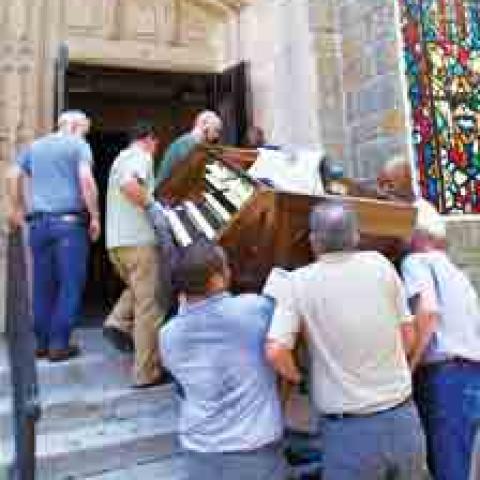Joe Vitacco graduated from Notre Dame in 1990 with a degree in business and a minor in music; his organ studies were with Craig Cramer. His interest in recording the pipe organ grew in the 1990s; he founded JAV Recordings in 1997 (website:

The Kilgen pipe organ at Our Lady of Refuge Church was built in 1933 by George Kilgen & Son of St. Louis, Missouri, as the firm’s Opus 5163, designed by Charles Courboin, then organist of St. Patrick’s Cathedral in New York City. The organ was delivered to the church early in 1934, and the work of installing, voicing, and finishing was completed in time for the church’s dedication in June.
The organ is located beneath the side tower of the church and speaks from two concrete chambers into the choir loft and then into the church. The pipes are totally hidden from sight. The console can be seen in the organ loft on the left-hand side of the nave.
In 2006 an effort was undertaken to get the historic pipe organ of the parish working after nearly a decade of silence. Inspection of the organ revealed that the first priority was to rebuild the bellows, and by January 2007 the organ was playing again for the first time in ten years. In spite of being badly in need of a full restoration, the organ impressed both the parish and the local community, many of whom were hearing it for the first time.
While the initial repairs were being carried out, a more serious problem came to light. The exterior pointing of the church was leaking, allowing water to seep into the organ chamber, threatening both the instrument itself and the structure of the church. The Organ Clearing House removed the organ from the church for safekeeping, before the repairs to the interior and exterior walls were carried out.
The parish has been able to raise awareness about their effort to save this historic instrument by creating a YouTube video of Stephen Tharp playing the organ at Our Lady of Refuge. This video was successful in initiating the fundraising effort, but more work remains to be done before the complete restoration of the organ will be possible. To assist the parish in this effort, several world-renowned organists have joined JAV Recordings in order to create a benefit CD. This includes recordings of the Kilgen organ at Our Lady of Refuge made prior to its removal, and also of recordings made on some famous organs in the United States, France and Germany—13 organists and 12 historic organs. All funds from this CD, less bank fees, will go directly to the restoration project. Performers include Léon Berben, David Briggs, Peter Conte, Ken Cowan, Craig Cramer, Christoph Frommen, Olivier Latry, Philippe Lefebvre, Jean-Pierre Leguay, Thomas Murray, Daniel Roth, John Scott, Stephen Tharp, Maîtrise Notre-Dame de Paris, and the University of Notre Dame Women’s Liturgical Choir.
The recordings form a two-CD set, accompanied by an extensive booklet describing the parish’s organ and the other featured organs. The booklet also contains a reflection from each of the organists on their first encounter with a pipe organ as well as informative notes on the music. (See review, page 18.)
Online resources include the website <www.olrbrooklyn.org/pipeorgan/> and a Facebook Group called “Friends of the Our Lady of Refuge Kilgen Organ.”
Tracks from the CD are available on iTunes. Search for “Our Lady of Refuge”—all funds received from Apple go right to the organ restoration fund.
Note that neither JAV Recordings nor I will in any way financially benefit from any of the fund-raising activities, and I have donated services to see this through. $40 is the minimum donation, which may be made by check payable to the church or credit-card payment online.
Our Lady of Refuge Church,
Brooklyn, New York
George Kilgen & Son, Inc.
Opus 5163
Great Organ
16′ Spitzflote
8′ Open Diapason
8′ Violin Diapason
8′ Flute Harmonic
8′ Dulciana (Ch)
4′ Octave
4′ Spitzflote (ext, Spitzflote)
22⁄3′ Twelfth
2′ Fifteenth
8′ Tromba
Chimes Deagan A
Swell Organ
16′ Lieblich Gedeckt
8′ Open Diapason
8′ Stopped Flute (ext, Lieblich)
8′ Salicional
8′ Voix Celeste
4′ Octave
4′ Flute d’Amour (ext, Lieblich)
2′ Flautino (ext, Lieblich)
Mixture III
16′ Posaune (ext, Cornopean)
8′ Cornopean
8′ Oboe
8′ Vox Humana
Choir Organ
8′ Violin Diapason (Gt)
8′ Spitzflote (Gt)
8′ Dulciana
8′ Unda Maris
4′ Flute (ext, Gt Spitzflote)
22⁄3′ Rohr Nazard
2′ Piccolo (ext, Gt Spitzflote)
8′ Clarinet
Pedal Organ
32′ Resultant (Sw Lieblich Gedeckt)
16′ Contra Bass
16′ Spitzflote (Gt)
16′ Bourdon
8′ Lieblich Gedeckt (Sw)
8′ Octave (ext, Contra Bass)
8′ Spitzflote (Gt)
8′ Flute (ext, Bourdon)
4′ Super Octave (ext, Contra Bass)
2′ Doublette (ext, Contra Bass)
16′ Trombone (ext, Gt Tromba)
16′ Posaune (Sw)
Chimes (Gt)




